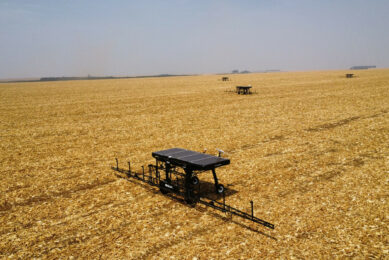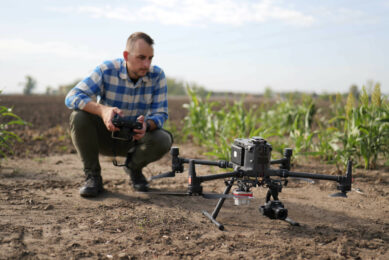Flying drones: the law per country

Worldwide legislation on drone use is evolving, with most countries moving towards similar regulations on flight operations. Continue reading to find out how the legislation is in different countries.
However, variations still exist, and while some authorities implement draconian rules, others have taken bolder steps to give farm drone operators more scope to exploit the developing technology.
Three key areas where drone rules differ are:
| ➤ Pilot certification ➤ Crop spraying ➤ Visual line of sight |
➤ Pilot certification
Neil Gabriel, training and operations manager at drone systems provider PrecisionHawk, says the UK has relatively flexible regulations compared with some countries.
“The Civil Aviation Authority, which administers the rules in the UK, is forward-looking and open to reviewing legislation where a change can be proved to be safe and necessary,” he says. By comparison, other EU countries have imposed measures that restrict flying.
Hover over a country in the map to learn more about its drone rules, or read the boxes below.
“In Spain, rules are extremely tight and commercial drone operators must hold a pilot’s licence. It’s a costly and time-consuming qualification to obtain and operators need to go well beyond what is needed to fly drones in most cases.
“Operators in the Netherlands face regulations that require each drone to be physically examined before use by government-approved assessors. “If an operator later modifies the software or equipment, the whole machine has to be sent away for checking all over again.”
UK commercial operators are less restricted, but must meet a list of criteria before flying commercially.
UK drone rules
The aircraft must not be flown beyond:
- Visual line of sight
- 500m (1,650ft) horizontally
- 122m (400ft) vertically
The aircraft must not be flown within:
- 150m (500ft) of a congested area
- 150m (500ft) of an open-air assembly of more than 1,000 people
- 50m (165ft) of any vessel, vehicle or structure
- 30m (100ft) of anyone other than the pilot except during take-off or landing
Commercial use
For drones weighing 20-150kg pilots must:
- hold a certificate of airworthiness
- register the drone with the CAA
- obtain permission from the CAA to operate the drone
- obtain an approved pilot qualification.
Source: Summary provided by Michelmores (Law Firm)
Commercial users in Britain also have to set out what is called an operations manual before the CAA will grant permission for commercial flying, Mr Gabriel explains.
This is a document produced by operators to demonstrate they have completed testing certificates and received training to gain an understanding of regulations, how the drone will be operated and for what purpose.
“The manual can run to many pages. For example, mine is 40 pages long and includes statements on risk assessment, flight checklists, emergency procedures and compliance with the Drone Safe code,” he adds.
Australia and the US are very similar to the UK and operators must also demonstrate competency.
US latest drone rules
The US Federal Aviation Authority relaxed its laws in 2016. Until 29 August 2016, US rules required operators to hold a pilot’s licence and have an observer on hand.
A knowledge test is used for a Remote Pilot Airman Certificate (RPAC) to certify the operator can work alone. Weight limits are not as permissive as Australia and drones must weigh less than 25kg – although waivers can be granted for larger machines.
Height restrictions have also been relaxed from 61m (200ft) to 122m (400ft), in line with regulations in other countries.
US drone operators are also allowed to fly above any “affiliated persons”, which includes everyone on the farm, making it easier to use cameras for crop analysis.
Commercial use laws meant consultants previously needed an exemption from the FAA to charge for drone services, but that is no longer required, as long as they are older than 16 and hold an RPAC.
➤Crop spraying
Since September 2016, farmers in Queensland, Australia, were granted permission to apply pesticides from drones, joining farmers in the US, Switzerland, New Zealand and China.
Pilots must be authorised by Australia’s Civil Aviation Safety Authority (Casa) and hold spray operator qualifications.
Australia latest drone rules
Australia has seen a relaxation in rules after laws were amended in September 2016.
The new rules created a number of exclusions for commercial users.
Remote operator certificate (ReOC) or remote pilot licence (RePL) requirements to fly drones up to 25kg no longer apply.
| Excluded operation | RePL | ReOC |
| 100g-2kg – commercial | No | No |
| 2-25kg – private landowner | No | No |
| 25-150kg – private landowner | Yes | No |
Weight limit changes mean Australian farmers can now fly drones up to 150kg, making it easier to carry heavier payloads for operations such as spraying.
However, the extended weight limit is restricted to those holding an RePL and to flights over land that is owned or lawfully occupied by the person who owns the drone. They must also follow standard operating conditions and ensure none of the parties involved receives remuneration for that work.
Beyond visual line of sight, flying is permitted in certain remote areas of uncontrolled airspace. Spraying rules mean some farmers are permitted to apply pesticides using drones.
This is one area where UK farmers lag behind. In the UK, spraying is yet to be permitted, although research work is under way to revise regulations.
Chris Eglington, director at agricultural drone specialist Crop Angel, explains countries that have already adopted spraying are more likely to have existing laws allowing aircraft to apply pesticides.
“It was a relatively simple adaptation of their laws to introduce spraying from drones,” says Mr Eglington.
In the UK it has not been as straightforward, because helicopter spraying is only permitted through derogation for tasks such as bracken spraying in remote areas on difficult terrain.
Drone spraying was also set back after the CAA made a key revision to laws.
“About 15 months ago a rule was brought in which said nothing could be dropped from a drone without special permission from the CAA,” Mr Eglington says.
The reasons given were potential danger to other aircraft and the possibility that loads could present a hazard if they fell. “It’s a pity because there are a number of benefits from drone spraying,” he adds.
Benefits of spraying crops using drones
- Zero ground compaction
- Spraying taller crops (maize)
- Access to difficult terrain
- Spraying under or around power lines pylons
- Time saving
- Spot spraying
- Mix smaller quantities
- Lower cost
- Reduced environmental risks
Mr Eglington, who farms in Norfolk, uses drones for crop assessment and believes it provides a foundation for targeted spraying using the equipment in the future.
“I can spot isolated problems with our rape crops from aerial mapping. So there is a potential to target these areas more precisely, using smaller quantities of pesticide. It would save time, fuel and pesticide costs while reducing the risk of ground compaction,” Mr Eglington says.
His team and other businesses, such as Harper Adams University and Northumberland-based Drone Ag, have been in dialogue with the CAA for about a year.
They are making progress, but Drone Ag’s Jack Wrangham points out that the CAA is just one of the legislative bodies covering drone spraying. “We must also gain approval from the Chemical Regulations Directorate [CRD],” says Mr Wrangham.
The CRD regulates pesticide use and requires testing of things like the chemical formulation itself and drift potential. Testing is scheduled to begin in 2018 and Drone Ag will work with Crop Angel, Harper Adams University and a chemical manufacturer.
The drones used will be 2m in diameter, weigh about 20kg and carry a 10-litre payload, 2-3m (6-10ft) above the vegetation.
“The system has active radar systems and uses real-time kinematic [RTK] global positioning to fly preset routes at location accuracies down to 1cm,” Mr Wrangham explains.
“Initially we are looking at covering about 1ha/hour [2.47 acres/hour], but if we can prove higher concentrations of active ingredients are safe, this area could be extended.”
Mr Wrangham is hopeful this will be completed successfully by the autumn of 2018. “We could then see the first limited commercial spraying in 2019, with a wider use developing from 2020.”
Beyond that Mr Wrangham suggests that developing technologies would eventually tie together flight programming with weed and disease surveillance software.
Eventually several drones could be sent off autonomously in groups to tackle larger areas, he says. While this would require further legislation changes, he suggests it would be possible to have tramline-free fields in as little as five to six years’ time.
➤ Visual line of sight
Visual line of sight (VLOS) rules operate in most countries and require that the operator can see the drone at all times. Australia is one place where it is possible to go beyond VLOS. In almost all countries a vertical limit of 122m (400ft) is attached to provide a separation distance between the lower limit of manned aircraft at 150m (500ft). In the UK only, VLOS also has a prescribed horizontal distance of 500m (1,650ft).
And PrecisionHawk’s Neil Gabriel says this is an important interpretation. “Larger drones can remain visible well beyond 500m. It is therefore a restriction on UK users that other countries may not have,” Mr Gabriel says.
It is possible to extend distances in the UK by applying for extended VLOS (Evlos) using an observer who can see the drone and is in contact with the pilot via radio.
Watch video: Heavy duty drone can cope with changeable UK weather
For that permission pilots have to establish an operating safety case (OCS) with the CAA. “But the amount of paperwork and restrictions mean only a couple of licences are issued a year,” says Mr Gabriel.
Drone Ag’s Jack Wrangham agrees that it would be “extremely useful not to have the 500m rule”. “For example, if I am mapping four fields in one flight, the farthest boundary can be well over 800m away.
“I can still see the drone, but I have to gather everything up and move to stay within the 500m rule.” Conversely there are times when nearby undulations block the line of sight.
Sense-and-avoid technology, remote viewing through imaging devices and pre-programmed return-to-home safety measures when the signal drops out, means it is safe to fly in rural areas where there is not much to hit, he says.
Further testing of this technology is taking place next year with the aim of proving beyond line of sight flying is safe.
Join 17,000+ subscribers
Subscribe to our newsletter to stay updated about all the need-to-know content in the agricultural sector, two times a week.




